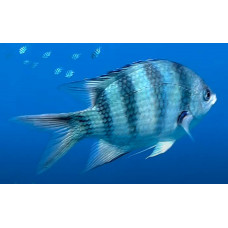Latin name
Abudefduf sexfasciatus
Other names
Striptailed damselfish
Identification
They get their name from the black stripes on their tail and flanks, which resemble the insignia of a military sergeant.
Features of fish fins
Dorsal spines (total): 13; Dorsal soft rays (total): 12-16; Anal spines: 2; Anal soft rays: 12-14.
Fish colouring
The fish are white. They have 5 vertical stripes that are black. The two horizontal stripes are on the tips of the tail.
Distribution
Found on reefs throughout the Indo-Pacific region. Habitats throughout the Indian Ocean include the Red Sea, East Africa, Madagascar, Seychelles, Persian Gulf, India, Sri Lanka, Bay of Bengal, Andaman Sea, Indonesia, and Australia. Populations in the Pacific Ocean include the Great Barrier Reef around Australia, the Gulf of Thailand, Indonesia, the Philippines, Taiwan, Japan, and various Pacific islands as far south as Hawaii.
Habitat
A marine tropical species. Adults inhabit coastal coral or rocky reefs. Also on shallow coastal reef shoals or ridges, usually where there are many large soft corals or colonies of hydroids, at depths down to 15 meters (50 feet). Juveniles inhabit the open ocean.
Size
Reach a length of about 16 centimeters (6.3 inches). The maximum length of this fish can reach 22 centimeters (8.7 inches).
Behavior
Often found in groups feeding in mid-water or nesting between rocks and coral ledges. Do not migrate.
Food and feeding habits
Feeds on invertebrate larvae, zooplankton, small fish, crustaceans, various types of algae, and sometimes its own eggs.
Reproduction
Egg-laying, mating during reproduction. Eggs are on the bottom and adhere to the substrate.
Males have parental responsibility, are polygamous, and can collect eggs from up to 12 females. They are capable of guarding multiple clutches of eggs while attracting new females. Occasionally, males may engage in cannibalism.
To select the best quality males and maximize offspring survival, females will pool their eggs with other females in the male's territory. Some females monitor the parental qualities of males by laying small clutches of "test eggs" in the male's territory. This unusual tactic is a direct way for females to confirm the parental ability of males who do not yet have eggs in their brood. Capable males prove their parental ability by protecting the brood and not destroying the eggs. Creating test eggs is energy intensive, so this strategy is usually only used by large females early in the mating season.
Fishing
Small commercial fishery. Fished for aquarium purposes.
Relationship with a person
This fish is very popular in the aquarium hobby. It's very aggressive.
| Classification | |
| Phylum | Chordata |
| Class | Actinopterygii |
| Family | Pomacentridae |
| Genus | Abudefduf |
| Species | A. sexfasciatus |
| Features | |
| Conservation status | Least Concern |
| Habitat | Pelagic |
| Life span, years | No information |
| Maximum body weight, kg | No information |
| Maximum length, cm | 22 |
| Sailing speed, m/s | No information |
| Threat to people | Not edible |
| Way of eating | Planktonophage |
Scissortail sergeant
Tags: scissortail sergeant



